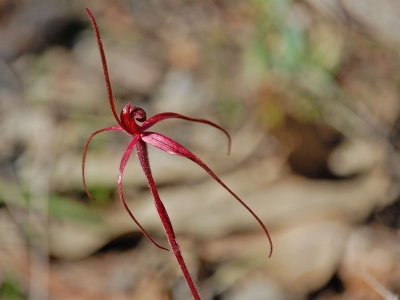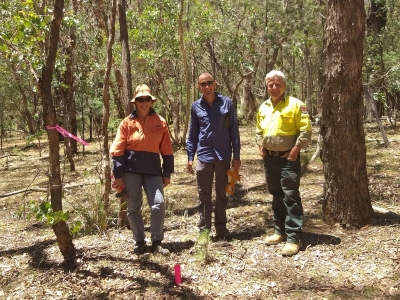Endangered orchid introduction into Woomargama National Park
NRM NEWS – MAY 2020 – SIGNIFICANT SPECIES
By Shanna Rogers
Senior Land Services Officer P: 02 6051 2241 | M: 0457 733 261 | E: shanna.rogers@lls.nsw.gov.au

Endangered crimson spider orchids will soon be introduced into Woomargama National Park.
The introduction is part of the NSW Environmental Trust funded Wild Orchids project.
The project aims to improve the long-term viability of three endangered orchid species: the Crimson Spider Orchid (Caladenia concolor), Sandhill Spider Orchid (Caladenia arenaria), and Oaklands Donkey Orchid (Diuris callitrophilla). These species now only occur in tiny numbers in the wild and are at considerable risk of extinction.
Monitoring in 2014 indicated that there were less than 75 Crimson Spider Orchids, fewer than 2000 Sandhill Spider Orchids and less than 1000 plants of the Oaklands Donkey Orchid left in the wild in NSW. In 2017 a new population of the Crimson Spider Orchid was discovered in Benambra National Park, boosting the wild population size to an estimated 600 plants in NSW.
To safeguard these orchid species from becoming extinct, we need to boost the population sizes to at least 3000 plants for each of the three species. To do this, we not only need to increase the abundance of plants within the existing population sites, but we also need to establish new populations.
Work is currently underway to set-up two areas within Woomargama National Park as translocation sites to establish new populations of the Crimson Spider Orchid. Parklands Albury Wodonga in partnership with Murray Local Land Services, Department of Planning, Industry and Environment – Conservation and Biodiversity Division, NSW National Parks and Wildlife Service and Woomargama National Parks Volunteers have started fencing out two 50 m x 20m areas.
Woomargama National Park is suitable for crimson spider orchids as it has similar vegetation species composition to the Nail Can Hill and Benambra National Park where the wild populations of Crimson Spider Orchids currently exist. Surveys by the Royal Botanic Gardens Victoria also confirmed that the key pollinator for crimson spider orchids, native Thynnine wasps were present at the translocation sites.
The two Woomargama sites will be planted out with laboratory-grown orchids propagated by experts from the Royal Botanic Gardens Victoria within the next two years. The planting out of the orchids will be a momentous step in the conservation and survival of the endangered Crimson Spider Orchid.

Top Photo: Crimson Spider Orchid, Matt Cameron; Bottom Photo: Anthea Packer from Parklands Albury Wodonga, Geoff Robertson from DPIE Biodiversity and Conservation Division, and Dave Pearce Woomargama National Park Ranger pegging out the new translocation site.